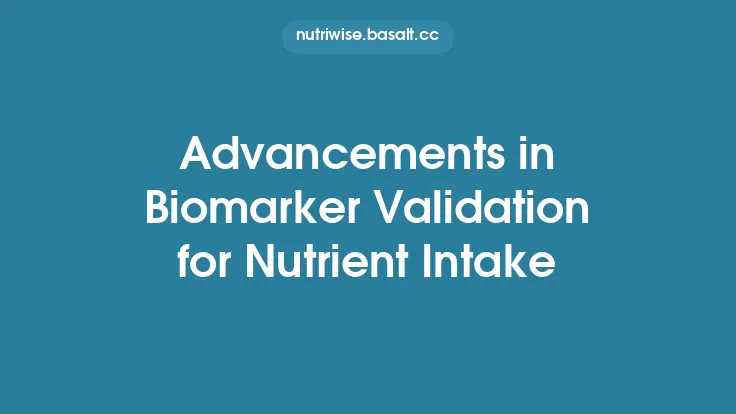Metabolomics, the comprehensive study of small‑molecule metabolites in biological specimens, has emerged as a powerful avenue for objectively quantifying dietary intake. Unlike self‑reported methods that are prone to recall bias and misreporting, metabolomics captures biochemical footprints left by foods and nutrients, providing a direct link between what is consumed and the molecular state of the body. Over the past decade, methodological advances—from high‑resolution mass spectrometry to sophisticated data‑normalization pipelines—have transformed metabolomics from a discovery tool into a viable component of dietary assessment in nutrition research. This article outlines the current state of the field, detailing the technical workflow, interpretive strategies, and practical considerations that enable researchers to harness metabolomics for objective dietary evaluation.
Principles of Metabolomics in Nutrition
Metabolomics operates on the premise that ingestion of foods introduces a myriad of exogenous compounds (e.g., phytochemicals, vitamins, fatty acids) and triggers endogenous metabolic responses (e.g., changes in amino‑acid catabolism, lipid remodeling). By profiling the resulting metabolite pool in biofluids such as plasma, urine, or saliva, researchers can infer recent and habitual dietary exposures. Two complementary approaches are typically employed:
- Targeted Metabolomics – quantifies a predefined set of metabolites with known nutritional relevance (e.g., plasma carotenoids, urinary polyphenol metabolites). This approach offers high analytical precision and facilitates direct comparison across studies.
- Untargeted (Global) Metabolomics – captures as many detectable features as possible, enabling the discovery of novel dietary biomarkers and the characterization of complex metabolic signatures associated with whole‑diet patterns.
Both strategies rely on the same analytical backbone but differ in the depth of annotation and the statistical treatment of the data.
Analytical Platforms and Their Evolution
The analytical engine of metabolomics is dominated by two high‑throughput technologies:
| Platform | Core Principle | Strengths | Limitations |
|---|---|---|---|
| Liquid Chromatography–Mass Spectrometry (LC‑MS) | Separation of polar and semi‑polar metabolites followed by mass detection | Broad coverage of metabolites, high sensitivity, amenable to both targeted and untargeted workflows | Requires extensive method development; matrix effects can affect quantitation |
| Gas Chromatography–Mass Spectrometry (GC‑MS) | Volatile or derivatized metabolites separated by gas chromatography | Excellent reproducibility, well‑established libraries for fatty acids, organic acids, and sugars | Limited to volatile or derivatizable compounds; derivatization adds complexity |
| Nuclear Magnetic Resonance (NMR) Spectroscopy | Direct detection of nuclei (commonly ^1H) in a magnetic field | Quantitative without external standards, highly reproducible, minimal sample preparation | Lower sensitivity compared with MS, limited to relatively abundant metabolites |
Recent advances have refined these platforms:
- Orbitrap and time‑of‑flight (TOF) mass analyzers now deliver sub‑ppm mass accuracy, facilitating confident elemental composition assignment.
- Hybrid quadrupole‑Orbitrap instruments enable simultaneous targeted quantification (via parallel reaction monitoring) and untargeted discovery within a single run.
- Microflow LC reduces solvent consumption and improves robustness for large‑scale studies.
- Cryogenic NMR probes have pushed detection limits, expanding the range of metabolites observable by NMR.
Collectively, these innovations have increased throughput, reduced analytical variance, and broadened the metabolite space accessible for dietary assessment.
Sample Collection and Pre‑analytical Considerations
The reliability of metabolomic data hinges on rigorous pre‑analytical protocols. Key factors include:
- Choice of Biofluid
- *Plasma/Serum*: Reflects systemic exposure; suitable for both acute and chronic dietary signals.
- *Urine*: Captures excreted metabolites, often providing higher concentrations of dietary xenobiotics.
- *Saliva*: Non‑invasive, useful for short‑term intake markers (e.g., caffeine).
- Timing Relative to Food Intake
- *Fasting samples* (≥8 h) minimize postprandial fluctuations, ideal for baseline metabolic profiling.
- *Standardized post‑prandial windows* (e.g., 2–4 h after a test meal) are essential when assessing acute dietary responses.
- Stabilization and Storage
- Immediate cooling on ice, followed by centrifugation at 4 °C, reduces enzymatic activity.
- Aliquoting into low‑binding tubes prevents repeated freeze‑thaw cycles; storage at –80 °C preserves metabolite integrity for years.
- Quality Control (QC) Samples
- Pooled QC (e.g., a mixture of all study samples) injected periodically throughout the analytical batch monitors instrument drift.
- Internal standards (stable‑isotope‑labeled compounds) added before extraction correct for extraction efficiency and ion suppression.
Adhering to these practices minimizes technical variability, ensuring that observed metabolic differences are attributable to dietary exposure rather than artefacts.
Data Processing and Metabolite Identification
Raw spectral data undergo a multi‑step transformation before biological interpretation:
- Peak Detection and Alignment
- Software such as XCMS (LC‑MS) or MZmine extracts ion features (m/z‑retention time pairs) and aligns them across samples, compensating for minor chromatographic shifts.
- Normalization
- *Total ion current (TIC) scaling, probabilistic quotient normalization (PQN)*, or *batch‑effect correction* (e.g., ComBat) adjust for systematic variations unrelated to biology.
- Feature Filtering
- Low‑abundance or poorly reproducible features (e.g., coefficient of variation >30 % in QC samples) are removed to improve statistical power.
- Metabolite Annotation
- Level 1 (Confirmed ID): Matching accurate mass, retention time, and MS/MS spectra to authentic standards.
- Level 2 (Probable ID): Matching accurate mass and MS/MS spectra to public databases (e.g., HMDB, METLIN).
- Level 3 (Tentative ID): Assigning a compound class based on spectral patterns.
- Level 4 (Unknown): Features lacking sufficient information.
The Metabolomics Standards Initiative (MSI) provides a framework for reporting these confidence levels, promoting transparency and reproducibility.
Linking Metabolite Profiles to Dietary Intake
Translating metabolomic signatures into quantitative dietary information involves several strategies:
- Biomarker‑Based Assessment
Specific metabolites serve as direct proxies for food consumption. For example, urinary excretion of 3‑hydroxy‑propyl‑caffeate reflects coffee intake, while plasma phosphatidylcholine species containing linoleic acid correlate with vegetable oil consumption.
- Pattern‑Recognition Approaches
Multivariate statistical models (e.g., principal component analysis, partial least squares discriminant analysis) identify clusters of metabolites that collectively differentiate dietary groups (e.g., high‑fruit vs. low‑fruit consumers). While these methods are statistical rather than machine‑learning intensive, they provide insight into dietary patterns without overreliance on complex algorithms.
- Dose‑Response Calibration
Controlled feeding studies generate calibration curves linking metabolite concentrations to known intake amounts. These curves enable back‑calculation of intake from observational data, converting relative metabolite signals into absolute dietary estimates.
- Integration with Traditional Dietary Data
Metabolomics can complement food frequency questionnaires (FFQs) or 24‑hour recalls by providing objective validation for specific items, thereby strengthening overall dietary assessment.
Quantitative Approaches and Calibration
Accurate quantification of dietary biomarkers requires careful calibration:
- Standard Curve Construction
- Serial dilutions of authentic standards are analyzed alongside study samples. Linear regression (or appropriate non‑linear models) yields concentration‑response relationships.
- Isotope Dilution
- Adding a known amount of a stable‑isotope‑labeled analogue of the target metabolite compensates for matrix effects and extraction losses, delivering absolute concentrations.
- Recovery Experiments
- Spiking known quantities of a biomarker into blank matrices (e.g., synthetic urine) assesses extraction efficiency, informing correction factors.
- Inter‑Laboratory Comparability
- Participation in external quality assessment schemes (e.g., the Metabolomics Quality Assurance and Control Consortium) ensures that quantitative results are comparable across sites, a prerequisite for large‑scale epidemiological applications.
Quality Assurance and Standardization
To embed metabolomics within routine dietary assessment, the field has converged on several best‑practice pillars:
- Standard Operating Procedures (SOPs) for sample handling, instrument tuning, and data acquisition are documented and shared among collaborating laboratories.
- Reference Materials (e.g., NIST Standard Reference Materials for human plasma) provide benchmark spectra for method verification.
- Transparent Reporting of analytical parameters (e.g., ion source settings, chromatographic gradients) and data‑processing workflows (including software versions) facilitates reproducibility.
- Statistical Power Planning incorporates expected effect sizes of dietary biomarkers, analytical variance, and multiple‑testing corrections, ensuring that studies are adequately powered to detect meaningful dietary differences.
Challenges and Limitations
Despite its promise, metabolomics for dietary assessment faces several hurdles:
- Biological Variability – Inter‑individual differences in gut microbiota, genetics, and metabolism can modulate biomarker levels, complicating the translation of metabolite concentrations to intake amounts.
- Temporal Resolution – Some metabolites reflect acute intake (hours), while others integrate longer‑term exposure (days to weeks). Selecting appropriate sampling windows is critical.
- Specificity vs. Sensitivity – Certain biomarkers are highly specific but present at low concentrations, demanding ultra‑sensitive instrumentation. Conversely, abundant metabolites may lack dietary specificity.
- Matrix Effects – Complex biological matrices can suppress or enhance ionization, leading to quantitation errors if not properly corrected.
- Regulatory Acceptance – For clinical or public‑health applications, metabolomic biomarkers must meet stringent validation criteria, which can be resource‑intensive.
Addressing these issues requires interdisciplinary collaboration among nutritionists, analytical chemists, biostatisticians, and clinicians.
Future Directions and Emerging Opportunities
The trajectory of metabolomics in dietary assessment points toward several exciting developments:
- Multi‑Omics Integration – Coupling metabolomics with genomics, transcriptomics, or microbiome data can disentangle host‑microbe‑diet interactions, refining biomarker specificity.
- High‑Throughput Targeted Panels – Commercially available kits focusing on validated dietary metabolites (e.g., polyphenol metabolites, fatty‑acid signatures) enable rapid, cost‑effective screening in large cohorts.
- Portable MS Platforms – Emerging ambient ionization techniques (e.g., paper spray MS) paired with miniaturized mass spectrometers hold promise for point‑of‑care dietary monitoring.
- Standardized Reference Databases – Community‑curated libraries linking foods to their metabolite fingerprints will accelerate biomarker discovery and validation.
- Regulatory Frameworks – As evidence accumulates, agencies may incorporate metabolomic biomarkers into dietary guidelines and nutrition labeling, providing an objective complement to self‑report measures.
In sum, metabolomics has matured into a robust, objective tool for dietary assessment. By leveraging high‑resolution analytical platforms, rigorous pre‑analytical protocols, and transparent data‑processing pipelines, researchers can generate reliable metabolic signatures that reflect food intake. While challenges remain—particularly regarding biological variability and standardization—the continued evolution of technology and collaborative standards positions metabolomics to become a cornerstone of nutrition research, delivering more accurate, reproducible, and mechanistically insightful dietary data for the next generation of studies.




